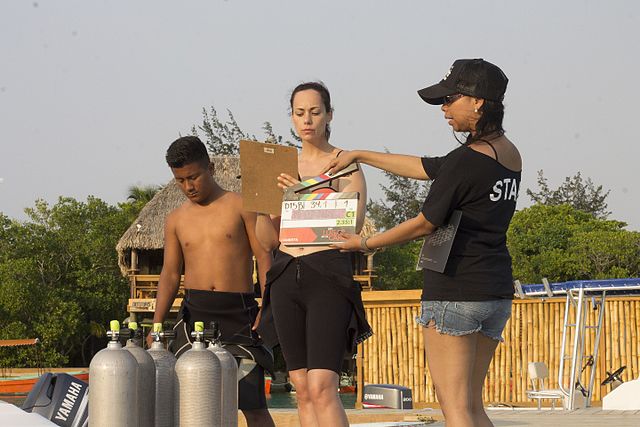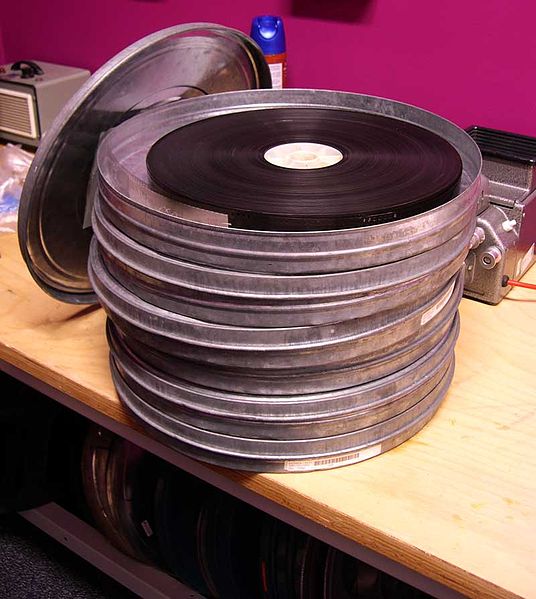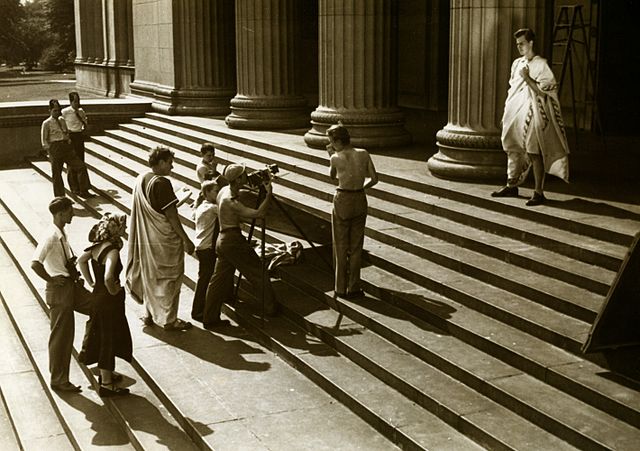A clapper loader or second assistant camera is part of a film crew whose main functions are that of loading the raw film stock into camera magazines, operating the clapperboard (slate) at the beginning of each take, marking the actors as necessary, and maintaining all records and paperwork for the camera department. The name "clapper loader" tends to be used in the United Kingdom and Commonwealth, while "second assistant camera" tends to be favored in the United States, but the job is essentially the same whichever title is used. The specific responsibilities and division of labor within the department will almost always vary depending on the circumstances of the shoot.
Clapper loader operating the clapperboard during the filming of A Place in the Caribbean (2017, Honduras)
Panavision R-200 movie camera (through-the-lens Reflex, 200 degree shutter, hence R-200). The camera magazine is inside the lighter color "blimp" on the top of the camera; the camera head is inside the darker color "blimp" on the bottom; the camera magazine can be removed to be reloaded by the clapper loader
A strip of undeveloped 35 mm color negative film from a roll; B&W negative film is similar; "Negative" may be inferred from the BH style perforations.
Each 35 mm roll contains a maximum of 2,000 feet, or 22.22 minutes of running time at 24 fps, with a customary maximum of 18–19 minutes.
A film crew is a group of people, hired by a production company, for the purpose of producing a film or motion picture. The crew is distinguished from the cast, as the cast are understood to be the actors who appear in front of the camera or provide voices for characters in the film. The crew is also separate from the producers, as the producers are the ones who own a portion of either the film studio or the film's intellectual property rights. A film crew is divided into different departments, each of which specializes in a specific aspect of the production. Film crew positions have evolved over the years, spurred by technological change, but many traditional jobs date from the early 20th century and are common across jurisdictions and filmmaking cultures.
Film director Dorothy Arzner had a successful career that spanned the silent film era into talkies. She started as a film editor and designed the first boom microphone.
A camera operator filming a scene from the Hollywood film Julius Caesar (1950), starring Charlton Heston.
Production of the television film Sherlock Holmes and the Case of the Silk Stocking (2004) at Somerset House in London.
Thelma Schoonmaker, a frequent collaborator on Martin Scorsese films, has received eight Academy Award nominations for Best Film Editing and has won three times—for Raging Bull (1980), The Aviator (2004), and The Departed (2006), which were all Scorsese-directed films.








